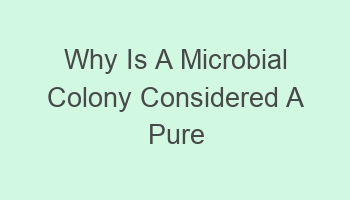Why Is A Microbial Colony Considered A Pure Culture?

Why Is A Microbial Colony Considered A Pure Culture? A microbial colony is considered a pure culture because it originates from a single cell. This ensures genetic uniformity within the colony. By isolating a single organism, researchers can study its characteristics and behavior accurately. This method allows for precise experimentation and analysis in microbiology. Understanding the purity of a culture is essential for reliable results in research and diagnostics. Pure cultures are crucial for identifying and studying specific microorganisms. The process of obtaining a pure culture involves careful techniques and strict protocols. Maintaining purity throughout experiments is vital for obtaining valid and reproducible data. Overall, a microbial colony is considered a pure culture due to its genetic homogeneity and the accuracy it provides in scientific studies.
Contents
| Microbial colonies are derived from a single cell, ensuring genetic uniformity. | A pure culture consists of only one type of microorganism. | It allows for accurate study of specific microbial characteristics. | Helps in identifying and characterizing microorganisms for research or industrial purposes. | Avoids contamination from other microorganisms in the environment. |
- A microbial colony helps in studying the genetic makeup of a single organism.
- It simplifies the process of identifying and isolating specific microbes.
- Allows for focused research on a particular microorganism without interference.
- Enables scientists to understand the behavior and characteristics of a single species.
- Essential for experiments requiring consistent and reproducible results.
What Is a Microbial Colony?
A microbial colony is a visible cluster of microorganisms that have grown from a single cell or a group of cells that have replicated on a solid medium. These colonies can be seen with the naked eye and are often used in microbiology to study and identify different types of bacteria, fungi, or other microbes.
- Colonies can vary in size, shape, color, and texture, providing valuable information about the characteristics of the microorganisms present.
- Each colony represents a population of genetically identical cells that have originated from a single cell, making them a useful tool for studying the behavior of specific microorganisms.
Why Are Microbial Colonies Important in Microbiology?
Microbial colonies are crucial in microbiology because they allow scientists to isolate and study individual species of microorganisms in a controlled environment. By growing colonies on agar plates, researchers can observe the growth patterns, morphology, and other characteristics of the microorganisms.
| Microbial colonies serve as a source of pure cultures for further study and experimentation. | They help in the identification and classification of different microorganisms based on their unique characteristics. |
How Is a Microbial Colony Formed?
A microbial colony is formed when a single cell or a group of cells land on a suitable medium and begin to replicate through binary fission. As the cells divide and grow, they form a visible mass that eventually becomes a distinguishable colony.
- The process of colony formation involves the cells multiplying and spreading out on the agar surface, creating a visible spot that can be picked and isolated for further study.
- Each colony contains millions of genetically identical cells that share the same genetic material, making them a pure culture of the original microorganism.
Can Microbial Colonies Contain Multiple Species?
While microbial colonies are typically formed by a single species of microorganism, it is possible for colonies to contain multiple species under certain conditions. This can occur when different types of microorganisms land on the same medium and grow in close proximity to each other.
| In mixed colonies, it can be challenging to isolate and study individual species, leading to contamination of the culture. | Special techniques, such as subculturing and selective media, are used to separate and identify different species within a mixed colony. |
What Makes a Microbial Colony a Pure Culture?
A microbial colony is considered a pure culture when it originates from a single cell and contains only genetically identical cells of the same species. This ensures that the colony is free from contamination and represents a homogenous population of microorganisms.
- Pure cultures are essential for conducting accurate experiments and tests in microbiology, as they allow researchers to study the characteristics and behavior of a single microorganism without interference from other species.
- To maintain the purity of a culture, microbiologists often use aseptic techniques and regularly subculture colonies to prevent contamination and preserve the genetic integrity of the cells.